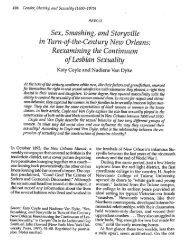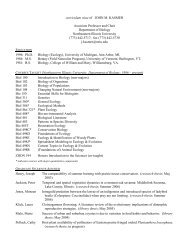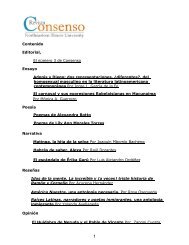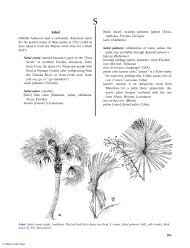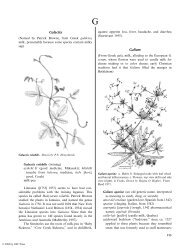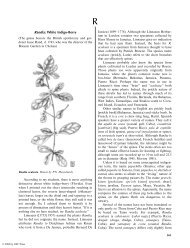Herba Cana - Northeastern Illinois University
Herba Cana - Northeastern Illinois University
Herba Cana - Northeastern Illinois University
Create successful ePaper yourself
Turn your PDF publications into a flip-book with our unique Google optimized e-Paper software.
© 2004 by CRC Press<br />
The Ethnobotany 493<br />
tolochlucco (big bay). By the 1950s, the Seminoles had<br />
shortened those names to to:li and to:lhátkí (white<br />
bay, M. virginica). What will be remembered in the<br />
next 200 years?<br />
Phalaris<br />
(Greek phalaris, phaleris, used by Dioscorides, fl. A.D.<br />
40 /80, for some kind of grass; presumably from<br />
phalaros, having a patch of white or crest, alluding to<br />
the inflorescence)<br />
alpiste (French)<br />
canaria (Italian); canary-grass (‘‘canary,’’ referring<br />
to the <strong>Cana</strong>ry Islands or <strong>Cana</strong>riae Insula [Isles<br />
of Dogs], a name used by Pliny, A.D. 23 /79);<br />
kanarigras (kanari, canary, gras, grass, Norwegian)<br />
Glanzgras (glanz, shiny, gras, grass, German)<br />
phalaride (French)<br />
reed-grass (a name most often used for Phragmites)<br />
ror-flen (ror, reed, flen= ?, Swedish)<br />
scagliola (Italian)<br />
strandror (strand, seashore, rør, reed, Norwegian)<br />
Phalaris caroliniana (of Carolina)<br />
baabkam [papkam] (pl., baahpakam) (‘‘it has a<br />
grandfather,’’ Akimel O’odham [Pima]; Rea’s<br />
informants could not give him a reason for the<br />
name; he speculated it must be an ancient poetic<br />
allusion)<br />
Carolina canary-grass [canarygrass]<br />
may-grass [maygrass] (‘‘May-grass’’ was in use by<br />
1830, but applied to Panicum latifolium; apparently<br />
applied to Phalaris ca. 1974, originally by<br />
archaeologists)<br />
Europeans knew at least three species of Phalaris<br />
when they arrived in the New World. Reed canarygrass<br />
(P. arundinacea) and Harding grass (P. aquatica<br />
L.) were grown for hay, while seeds of canary grass (P.<br />
canariensis) were eaten by people. There are about 20<br />
species in Phalaris, with 7 native to Europe (Mabberley<br />
1997). Phalaris caroliniana was named by Walter in<br />
1788, and now grows from Florida to California and<br />
Mexico, north to Maryland, Tennessee, Missouri,<br />
Kansas, Colorado, and Oregon.<br />
May-grass is a starchy-seeded annual grass whose<br />
grains (caryopses) are dominant in Middle and Late<br />
Woodland archaeological sites (Crites and Terry 1984,<br />
Asch and Asch 1985). The grains have been associated<br />
with people in <strong>Illinois</strong>, dating 17009/70 B.P. in one site<br />
and 14009/70 B.P. at another site. It was already an<br />
important cultivated food in Kentucky in 1000 B.C.<br />
Fritz (2000b) concluded that it was a domesticated<br />
crop by 3000 B.P.<br />
Moerman (1998) found the species being used only<br />
by the Gila River Pima, based on a report by Amadeo<br />
Rea. Subsequently, Rea (1997) provided more information<br />
on may-grass use. While reading through a<br />
1908 report by Frank Russell, Rea noticed an unidentified<br />
grass the O’odham had called papkam. He<br />
realized that it was what modern people call baabkam.<br />
Russell wrote, ‘‘The heads are tied in bunches and<br />
dried in the sun. They are then shelled, screened, the<br />
seeds parched, ground on the metate, and eaten in<br />
pinole. They are ‘not sweet.’’’ One of Rea’s O’odham<br />
friends had told him the seeds were once eaten but did<br />
not taste good. These grasses are another member of<br />
the Eastern Agricultural Complex that was abandoned<br />
when maize agriculture became widespread.<br />
Phaseolus<br />
(From Greek phaseolos, a little boat, light vessel,<br />
referring to the similarity between the pod and the<br />
craft; used by Dioscorides, fl. A.D. 40 /80, for what<br />
Agnes Arber identified as Vigna unguiculata, cf. Meyer<br />
et al. 1999; known as faseolus or phaseolus to<br />
Romans)<br />
Phaseolus polystachios. From Britton and Brown 1897.<br />
Phaseolus polystachios (many-spiked)<br />
[thicket, wild] bean [vine]<br />
sacsac (Delaware)<br />
Phaseolus vulgaris (common)<br />
acayotle (maybe from acatl, cane, etl, bean,<br />
Náhuatl, recorded by Humboldt fide Hedrick<br />
1919)





